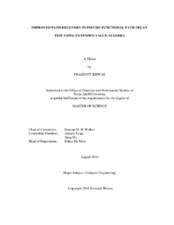| dc.description.abstract | Scan-based delay test achieves high fault coverage due to its improved controllability and observability. This is particularly important for our K Longest Paths Per Gate (KLPG) test approach, which has additional necessary assignments on the paths. At the same time, some percentage of the flip-flops in the circuit will not scan, increasing the difficulty in test generation. In particular, there is no direct control on the outputs of those non-scan cells. All the non-scan cells that cannot be initialized are considered “uncontrollable” in the test generation process. They behave like “black boxes” and, thus, may block a potential path propagation, resulting in path delay test coverage loss. It is common for the timing critical paths in a circuit to pass through nodes influenced by the non-scan cells.
In our work, we have extended the traditional Boolean algebra by including the “uncontrolled” state as a legal logic state, so that we can improve path coverage. Many path pruning decisions can be taken much earlier and many of the lost paths due to uncontrollable non-scan cells can be recovered, increasing path coverage and potentially reducing average CPU time per path. We have extended the existing traditional algebra to an 11-value algebra: Zero (stable), One (stable), Unknown, Uncontrollable, Rise, Fall, Zero/Uncontrollable, One/Uncontrollable, Unknown/Uncontrollable, Rise/Uncontrollable, and Fall/Uncontrollable. The logic descriptions for the NOT, AND, NAND, OR, NOR, XOR, XNOR, PI, Buff, Mux, TSL, TSH, TSLI, TSHI, TIE1 and TIE0 cells in the ISCAS89 benchmark circuits have been extended to the 11-value truth table.
With 10% non-scan flip-flops, improved path delay fault coverage has been observed in comparison to that with the traditional algebra. The greater the number of long paths we want to test; the greater the path recovery advantage we achieve using our algebra. Along with improved path recovery, we have been able to test a greater number of transition fault sites. In most cases, the average CPU time per path is also lower while using the 11-value algebra. The number of tested paths increased by an average of 1.9x for robust tests, and 2.2x for non-robust tests, for K=5 (five longest rising and five longest falling transition paths through each line in the circuit), using the eleven-value algebra in contrast to the traditional algebra. The transition fault coverage increased by an average of 70%. The improvement increased with higher K values. The CPU time using the extended algebra increased by an average of 20%. So the CPU time per path decreased by an average of 40%. In future work, the extended algebra can achieve better test coverage for memory intensive circuits, circuits with logic black boxes, third party IPs, and analog units. | en |


